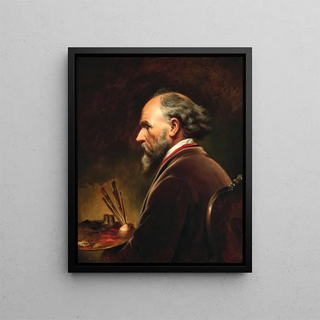Painting Self-portrait - Friedrich von Amerling | Art print


View from behind

Frame (optional)
Friedrich von Amerling's Self-Portrait is an iconic artwork that showcases the technical mastery and artistic sensitivity of its creator. Created in the heart of the 19th century, this painting offers a fascinating glimpse into the inner world of the artist, while revealing the aesthetic conventions of his time. Through this portrait, Amerling does not merely depict his image; he invites the viewer to explore the nuances of his identity, the subtleties of his emotions, and the profound reflections that inhabit him. The delicate light caressing his face and the richness of the details in his costume make it a vivid testament to an era when art was a window to the soul.
Style and uniqueness of the work
Friedrich von Amerling's Self-Portrait stands out for its refined academic style, characteristic of the Romantic movement. The artist employs a palette of soft colors, blending warm and cool tones that create an intimate atmosphere. Every brushstroke seems charged with emotion, and the precision of the details—whether in the rendering of textures or in the expression of the face—testifies to a concern for realism and a meticulous aesthetic pursuit. The artist's penetrating gaze, both confident and introspective, captures attention and invites prolonged contemplation. The composition, well-balanced, emphasizes the stature of the artist while revealing a touching vulnerability, thus adding a human dimension to this portrait that might otherwise appear cold and distant.
The artist and his influence
Friedrich von Amerling, born in 1803 in Vienna, is one of the most prominent portraitists of his time. Trained in the workshops of great masters, he managed to establish himself thanks to his exceptional talent and his ability to capture the very essence of his subjects. His influence extends well beyond Austrian borders, affecting generations of artists who saw in him a role model. Amerling successfully combined tradition and innovation, integrating elements of Romanticism while foreshadowing certain trends of Realism. His work, of which the Self-Portrait is a striking example, continues to inspire and fascinate, bearing witness to a

Matte finish

View from behind

Frame (optional)
Friedrich von Amerling's Self-Portrait is an iconic artwork that showcases the technical mastery and artistic sensitivity of its creator. Created in the heart of the 19th century, this painting offers a fascinating glimpse into the inner world of the artist, while revealing the aesthetic conventions of his time. Through this portrait, Amerling does not merely depict his image; he invites the viewer to explore the nuances of his identity, the subtleties of his emotions, and the profound reflections that inhabit him. The delicate light caressing his face and the richness of the details in his costume make it a vivid testament to an era when art was a window to the soul.
Style and uniqueness of the work
Friedrich von Amerling's Self-Portrait stands out for its refined academic style, characteristic of the Romantic movement. The artist employs a palette of soft colors, blending warm and cool tones that create an intimate atmosphere. Every brushstroke seems charged with emotion, and the precision of the details—whether in the rendering of textures or in the expression of the face—testifies to a concern for realism and a meticulous aesthetic pursuit. The artist's penetrating gaze, both confident and introspective, captures attention and invites prolonged contemplation. The composition, well-balanced, emphasizes the stature of the artist while revealing a touching vulnerability, thus adding a human dimension to this portrait that might otherwise appear cold and distant.
The artist and his influence
Friedrich von Amerling, born in 1803 in Vienna, is one of the most prominent portraitists of his time. Trained in the workshops of great masters, he managed to establish himself thanks to his exceptional talent and his ability to capture the very essence of his subjects. His influence extends well beyond Austrian borders, affecting generations of artists who saw in him a role model. Amerling successfully combined tradition and innovation, integrating elements of Romanticism while foreshadowing certain trends of Realism. His work, of which the Self-Portrait is a striking example, continues to inspire and fascinate, bearing witness to a
12,34 €






